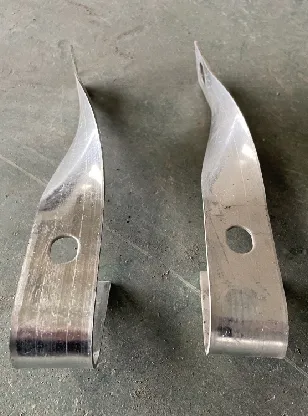loading...
- No. 9, Xingyuan South Street, Dongwaihuan Road, Zaoqiang County, Hengshui, Hebei, China
- admin@zjcomposites.com
- +86 15097380338
- Welcome to visit our website!
Innovative Applications of Fiber Reinforced Polymer Grating Sheets in Construction
Understanding FRP Grating Sheets An Overview
FRP (Fiberglass Reinforced Plastic) grating sheets have emerged as a popular choice in various industries due to their exceptional strength, durability, and resistance to corrosion. This innovative material combines fiberglass and resin into a solid structure, making it an ideal alternative to traditional materials such as steel and aluminum in many applications. In this article, we will explore the characteristics, advantages, applications, and maintenance of FRP grating sheets, providing valuable insights for those considering their use.
Characteristics of FRP Grating Sheets
FRP grating sheets are fabricated by combining a thermosetting resin, such as polyester or vinyl ester, with glass fibers. This composite structure offers several beneficial characteristics
1. Lightweight FRP grating is significantly lighter than steel or aluminum, making it easier to handle and install. This characteristic can lead to reduced transportation costs and labor expenses.
2. Corrosion Resistance One of the most significant advantages of FRP is its resistance to a wide range of chemicals and environmental conditions. This makes it highly suitable for industries such as wastewater treatment, chemical processing, and marine environments where corrosive substances are prevalent.
3. High Strength-to-Weight Ratio Despite being lightweight, FRP grating has an impressive load-bearing capacity. Its design and materials provide the strength necessary to withstand heavy loads, making it suitable for various structural applications.
4. Non-Conductive As an electrical insulator, FRP grating is an excellent choice for environments where electrical safety is a concern. It minimizes the risk of electrical hazards, especially in areas where workers are exposed to potential electrical shocks.
5. Versatility FRP grating sheets can be fabricated into various shapes, sizes, and configurations. This flexibility allows for customization according to specific project requirements.
Advantages of FRP Grating Sheets
The advantages of using FRP grating sheets over traditional materials are numerous
1. Reduced Maintenance The corrosion resistance of FRP leads to lower maintenance costs and longer service life compared to metals, which often require regular upkeep to prevent rust and degradation.
2. Safety The non-slip surface is another key advantage. Many FRP grating sheets come with a slip-resistant surface, enhancing safety in areas with high foot traffic or where wet conditions are frequent.
3. Cost Effectiveness While the initial investment may be higher than some traditional materials, the long-term savings due to reduced maintenance and replacement costs make FRP grating an economically viable choice.
frp grating sheet

4. Sustainability With an increasing emphasis on sustainable materials, FRP grating can be manufactured using recycled content. Furthermore, it is often designed for a long life cycle, minimizing waste.
Applications of FRP Grating Sheets
FRP grating sheets are utilized in a broad range of applications across various industries
1. Industrial Facilities Many manufacturing plants use FRP grating for walkways, platforms, and drainage covers due to its strength and resistance to chemicals.
2. Marine Environments In shipbuilding and port facilities, FRP grating is employed for decking, walkways, and gangways, given its resilience to saltwater and UV exposure.
3. Wastewater Treatment Plants The corrosion resistance of FRP makes it suitable for environments where there is exposure to harsh chemicals and waste products.
4. Pulp and Paper Industry Given the high levels of moisture and potential for chemical exposure, FRP grating provides a reliable solution for flooring and platforms in such facilities.
5. Pedestrian Walkways FRP grating is increasingly used in urban environments for pedestrian bridges and walkways, providing a lightweight, durable, and slip-resistant surface for foot traffic.
Maintenance of FRP Grating Sheets
While FRP grating sheets require minimal maintenance, some guidelines should be followed to ensure their longevity
1. Routine Inspections Regular checks for signs of wear, damage, or chemical exposure can help identify potential issues before they become significant problems.
2. Cleaning Keeping the surface clean from debris, oil, or chemicals will help maintain its slip-resistant properties and aesthetic.
3. Repairs Minor damage can often be repaired easily with resin and fiberglass patches, allowing for a swift return to service.
In conclusion, FRP grating sheets offer a range of beneficial properties that make them a formidable choice for many applications. Their lightweight nature, corrosion resistance, and ease of maintenance position them as a modern alternative to traditional materials, providing safety and cost-effectiveness across various industries. As industries continue to evolve, the demand for innovative solutions like FRP grating will undoubtedly grow, reinforcing its importance in the market.
-
The Rise of FRP Profiles: Strong, Lightweight, and Built to LastNewsJul.14,2025
-
SMC Panel Tanks: A Modern Water Storage Solution for All EnvironmentsNewsJul.14,2025
-
GRP Grating: A Modern Solution for Safe and Durable Access SystemsNewsJul.14,2025
-
Galvanized Steel Water Tanks: Durable, Reliable, and Ready for UseNewsJul.14,2025
-
FRP Mini Mesh Grating: The Safer, Smarter Flooring SolutionNewsJul.14,2025
-
Exploring FRP Vessels: Durable Solutions for Modern Fluid HandlingNewsJul.14,2025
-
GRP Structures: The Future of Lightweight, High-Performance EngineeringNewsJun.20,2025
